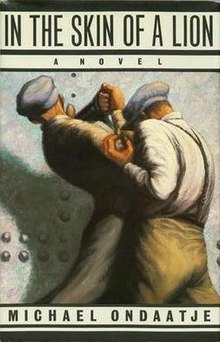 First edition | |
| Author | Michael Ondaatje |
|---|---|
| Language | English |
| Genre | Fiction, Historical Fiction |
| Publisher | McClelland and Stewart |
Publication date | 1987 |
| Publication place | Canada |
| Media type | |
| Pages | 243 |
| Awards | Governor General's Award |
| ISBN | 0394563638 |
| OCLC | 16089069 |
In the Skin of a Lion is a novel by Canadian–Sri Lankan writer Michael Ondaatje. It was first published in 1987 by McClelland and Stewart. The novel fictionalizes the lives of the immigrants who played a large role in the building of the city of Toronto in the early 1900s,[1] but whose contributions never became part of the city's official history.[2] Ondaatje illuminates the investment of these settlers in Canada, through their labour, while they remain outsiders to mainstream society. In the Skin of a Lion is thus an exposé of the migrant condition: "It is a novel about the wearing and the removal of masks; the shedding of skin, the transformations and translations of identity."[3]
An important aspect of the novel is its depiction of Toronto in the 1930s. Ondaatje spent many months in the archives of the City of Toronto and newspapers of the era. Prominence is given to the construction of two Toronto landmarks, the Prince Edward Viaduct, commonly known as the Bloor Street Viaduct, and the R. C. Harris Water Treatment Plant, and focuses on the lives of the immigrant workers.[4] The plot incorporates a number of true stories of the time, such as the fall of a nun from a bridge,[5] the disappearance of Ambrose Small, the political suppression of Police Chief Draper, and the murder of labour union organizers Rosvall and Voutilainen.
In a minor section of the novel, Patrick Lewis visits Paris, Ontario in which Ondaatje describes various parts of the town including: Broadway Street, Wheelers Needleworks, Medusa, Paris Plains, just north of the town, the Arlington hotel, and Paris Public Library.
The novel's title is taken from a line in The Epic of Gilgamesh, following the death of Enkidu. It is located in the epigraph as "I will let my hair grow long for your sake, I will wander through the wilderness in the skin of a lion," echoing the theme of converging voices re-telling history.
The book was nominated for the Governor General's Award for English Language Fiction in 1987. Ondaatje's more famous 1992 novel, The English Patient, is, in part, a sequel to In the Skin of a Lion, continuing the characters of Hana and Caravaggio as well as revealing the fate of this novel's main character, Patrick Lewis.
- ^ Thesen, Sharon. "Michael Ondaatje". The Canadian Encyclopedia. Archived from the original on 2019-04-13. Retrieved 2016-12-01.
- ^ Devi, S. Poorna Mala. "Immigrants' experience in Michael Ondaatje's novels in the skin of a lion and the English patient." Language In India, January 2015, 547+. Literature Resource Center (accessed December 1, 2016). http://go.galegroup.com/ps/i.do?p=GLS&sw=w&u=ocul_carleton&v=2.1&it=r&id=GALE%7CA404830601&asid=61174144a6b42fbc8556f9c27c32c1c3 Archived 2017-10-24 at the Wayback Machine
- ^ "Michael Ondaatje – Literature". literature.britishcouncil.org. Archived from the original on 2019-03-27. Retrieved 2016-12-01.
- ^ "Michael Ondaatje." In An Anthology of Canadian Literature in English, edited by Donna Bennett and Russell Brown, 928-30. 3rd ed. Toronto, ON: Oxford University Press, 2010.
- ^ Kuitenbrouwer, Peter (April 24, 2009). "Bookmarking Ondaatje's viaduct story". National Post. Toronto. Archived from the original on 2018-07-25. Retrieved 2018-07-25.
